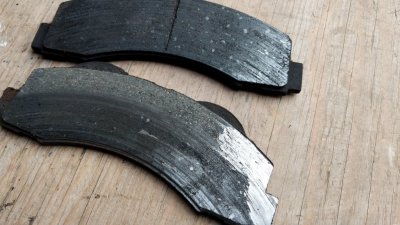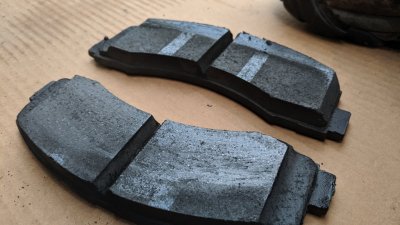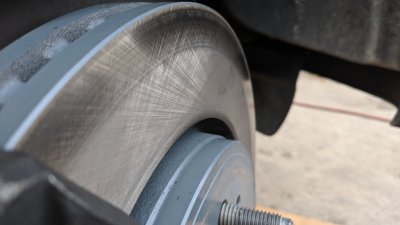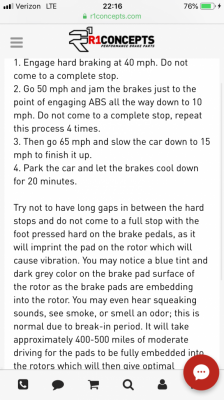Guys, I guess I'll find out for real today but it
seems that it's fixed. I'm a little tentative. Yesterday, I nearly lost all of my religion. I was so frustrated with yet
another "simple" procedure becoming a long, drawn-out ordeal. I owe it folks like you who willingly take the time to give a quick reply - even in the middle of a beautiful Saturday (or Friday) to help me out.
I took a break from the vehicle and worked a little bit on my boat. I had to fix up a "simple procedure" that ended up being a long, drawn-out thing...
Got to the vehicle in a relaxed mood and got comfortable.
Was determined to take the thing apart slowly and find out when the wheel freed up (if it did at all) and what was causing the binding. As soon as I got the wheel off, I was reminded of the fact that already, the wear on the rotors was not even, only on the outer half. That indicated something - but what? Something was not aligned. Was something bent?
With the wheel off, the new rotor was a little loose on the hub, with the only thing keeping it there was the caliper/pads, of course. I now, however, could spin the rub relatively easily with my hand. However, when I pressed the rotor flush against the hub and did so, it was tight!
Then I removed the caliper and repeated the procedure. This time, the rotor spun very, very freely while pressed against the hub (as it should). I was pretty sure that there was no wheel bearing issue. No sound or resistance at all.
Following advice given here (thanks, guys),
I took the pads to the bench grinder. I figured that maybe they were a little tight in there. I just ground the paint off the end basically and rounded over the edges just a bit. Touched it up on the wire wheel, greased the ends, and put them back in.
As I tried to put the caliper back on, I found it stuck - there was something that was not letting the caliper past. Well, it turns out that the backsides of the pair of pads were not identical. There were two raised studs on the backside of the inside pad. Both of these studs were scuffed pretty bad. I realized that they were not lined up under the center of the caliper cylinders. In fact, I think they rested on the rim of the caliper cylinders. To me, that would affect the alignment of the pads as the caliper was tightened and brake pressure applied. The outside pad had no such 'studs'. Since there is nothing touching the backside of the pads (for the most part) on the outside, I switched the pads.
Reassembled and the wheel spun as I expected it to. It did not run on and on but if I gave it a good spin, it might turn 1.5 revolutions before stopping. Only a slight noise of pad against the rotor. I gave God a little thanks and dropped the vehicle back to the ground. Just then I realized I had not applied any brake pressure and then tested the spin.
Took it for a drive. As before, it seemed like nothing was wrong. We drove a couple of miles, came back, and found that
the hub was cool to the touch. Jacked it up and it spun as before.
Fingers crossed. Thank you all very very much. I hope I'm not back updating this thread with any bad news.
 A few photos:
A few photos:
A shot of the pads I replaced at Christmas. I should've known I had a problem by the uneven wear of the one pad.

These the new pads from yesterday (not the new ones from the previous week). This after a 4-mile test drive. Inner pad closest to you. (should note this is from the right front of the vehicle).

The rotor after the same 4-mile test drive.







